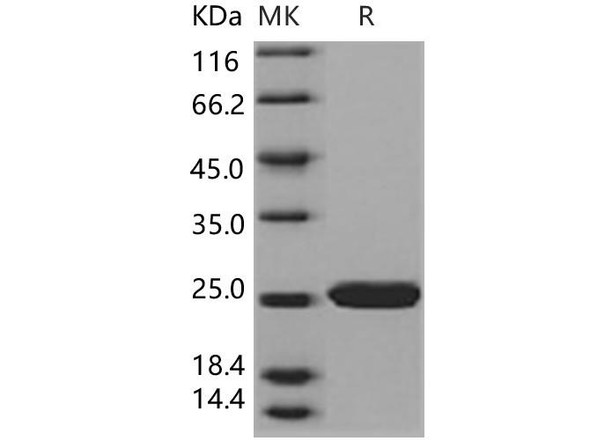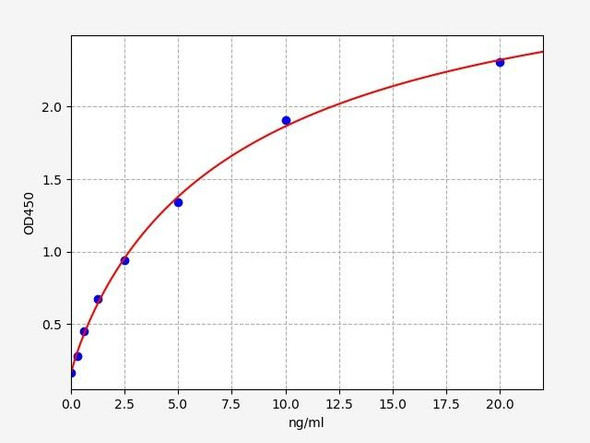Description
| Product Name: | Mouse SOD2 Recombinant Protein |
| Product Code: | RPPB4776 |
| Size: | 20µg |
| Species: | Mouse |
| Target: | SOD2 |
| Synonyms: | Superoxide dismutase [Mn], Superoxide Dismutase-2, mitochondrial, Sod-2. |
| Source: | Escherichia Coli |
| Physical Appearance: | Sterile Filtered clear solution. |
| Formulation: | SOD2 protein solution (1mg/ml) containing Phosphate buffered saline (pH7.4), 10% glycerol and 1mM DTT. |
| Stability: | Store at 4°C if entire vial will be used within 2-4 weeks. Store, frozen at -20°C for longer periods of time. For long term storage it is recommended to add a carrier protein (0.1% HSA or BSA).Avoid multiple freeze-thaw cycles. |
| Purity: | Greater than 95.0% as determined by SDS-PAGE. |
| Amino Acid Sequence: | MGSSHHHHHH SSGLVPRGSH MGSKHSLPDL PYDYGALEPH INAQIMQLHH SKHHAAYVNN LNATEEKYHE ALAKGDVTTQ VALQPALKFN GGGHINHTIF WTNLSPKGGG EPKGELLEAI KRDFGSFEKF KEKLTAVSVG VQGSGWGWLG FNKEQGRLQI AACSNQDPLQ GTTGLIPLLG IDVWEHAYYL QYKNVRPDYL KAIWNVINWE NVTERYTACK K |
SOD2 is part of the iron/manganese superoxide dismutase family. It encodes a mitochondrial protein that forms a homotetramer and binds one manganese ion per subunit. SOD2 binds to the superoxide byproducts of oxidative phosphorylation and converts them to hydrogen peroxide and diatomic oxygen. Mutations in SOD2 gene have been associated with idiopathic cardiomyopathy (IDC), premature aging, sporadic motor neuron disease, and cancer. SOD2 destroys radicals which are usually produced within the cells and which are toxic to biological systems.
SOD2 Mouse Recombinant produced in E.Coli is a single, non-glycosylated polypeptide chain containing 221 amino acids (25-222 a.a) and having a molecular mass of 24.6kDa.SOD2 is fused to a 23 amino acid His-tag at N-terminus & purified by proprietary chromatographic techniques.
| UniProt Protein Function: | SOD2: Destroys superoxide anion radicals which are normally produced within the cells and which are toxic to biological systems. Genetic variation in SOD2 is associated with susceptibility to microvascular complications of diabetes type 6 (MVCD6). These are pathological conditions that develop in numerous tissues and organs as a consequence of diabetes mellitus. They include diabetic retinopathy, diabetic nephropathy leading to end-stage renal disease, and diabetic neuropathy. Diabetic retinopathy remains the major cause of new- onset blindness among diabetic adults. It is characterized by vascular permeability and increased tissue ischemia and angiogenesis. Belongs to the iron/manganese superoxide dismutase family. 2 isoforms of the human protein are produced by alternative splicing. |
| UniProt Protein Details: | Protein type:EC 1.15.1.1; Oxidoreductase; Mitochondrial Cellular Component: mitochondrion; cytoplasm; mitochondrial inner membrane; intracellular; myelin sheath Molecular Function:identical protein binding; protein binding; DNA binding; manganese ion binding; metal ion binding; superoxide dismutase activity; oxidoreductase activity; oxygen binding Biological Process: oxygen homeostasis; positive regulation of nitric oxide biosynthetic process; removal of superoxide radicals; heart development; locomotory behavior; vasodilation; post-embryonic development; age-dependent response to oxidative stress; protein homotetramerization; negative regulation of cell proliferation; apoptotic mitochondrial changes; glutathione metabolic process; sensory perception of sound; regulation of mitochondrial membrane potential; acetylcholine vasodilation involved in regulation of systemic arterial blood pressure; regulation of catalytic activity; regulation of blood pressure; response to gamma radiation; hemopoiesis; response to axon injury; negative regulation of neuron apoptosis; protein homooligomerization; response to drug; response to nutrient levels; erythrophore differentiation; mitochondrion organization and biogenesis; release of cytochrome c from mitochondria; response to superoxide; superoxide metabolic process; liver development; negative regulation of fat cell differentiation; regulation of transcription from RNA polymerase II promoter; iron ion homeostasis; response to reactive oxygen species; response to hyperoxia; DNA damage response, signal transduction resulting in induction of apoptosis; response to hydrogen peroxide; age-dependent response to reactive oxygen species; negative regulation of fibroblast proliferation; detection of oxygen; hydrogen peroxide metabolic process; neuron development; response to oxidative stress; response to activity; induction of apoptosis by oxidative stress; superoxide release; hydrogen peroxide biosynthetic process; negative regulation of apoptosis |
| UniProt Code: | P09671 |
| NCBI GenInfo Identifier: | 31980762 |
| NCBI Gene ID: | 20656 |
| NCBI Accession: | NP_038699.2 |
| UniProt Secondary Accession: | P09671,Q64670, Q8VEM5, |
| UniProt Related Accession: | P09671 |
| Molecular Weight: | 24,603 Da |
| NCBI Full Name: | superoxide dismutase |
| NCBI Synonym Full Names: | superoxide dismutase 2, mitochondrial |
| NCBI Official Symbol: | Sod2�� |
| NCBI Official Synonym Symbols: | MnSOD; Sod-2�� |
| NCBI Protein Information: | superoxide dismutase [Mn], mitochondrial; superoxide dismutase [Mn], mitochondrial; manganese SOD; manganese superoxide dismutase |
| UniProt Protein Name: | Superoxide dismutase [Mn], mitochondrial |
| Protein Family: | Superoxide dismutase |
| UniProt Gene Name: | Sod2�� |
| UniProt Entry Name: | SODM_MOUSE |






